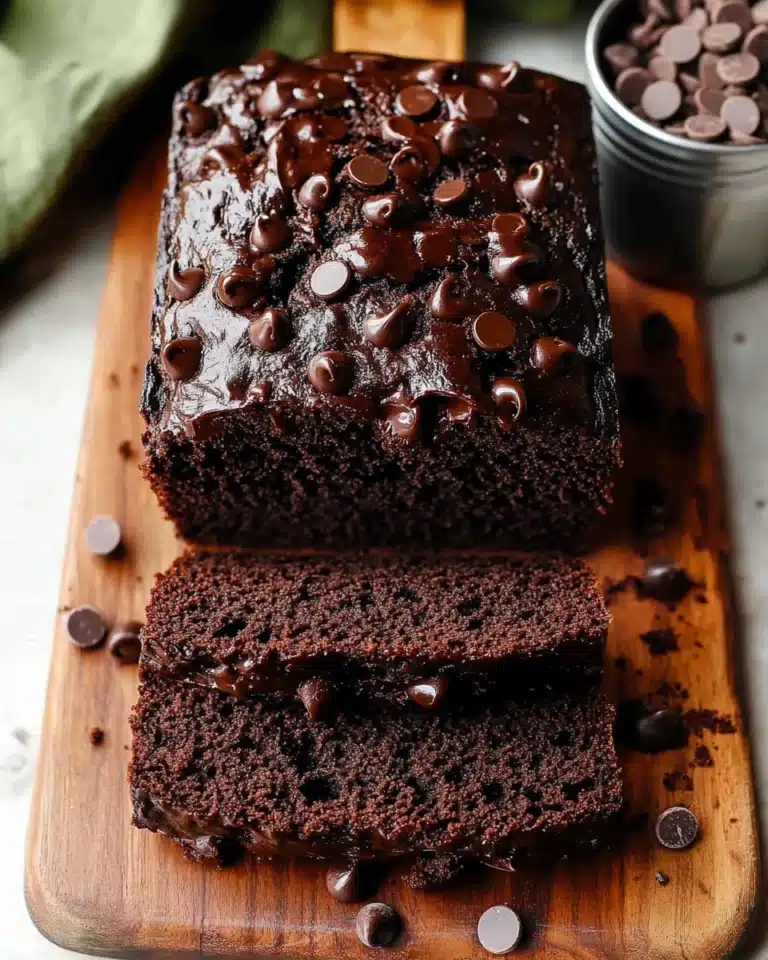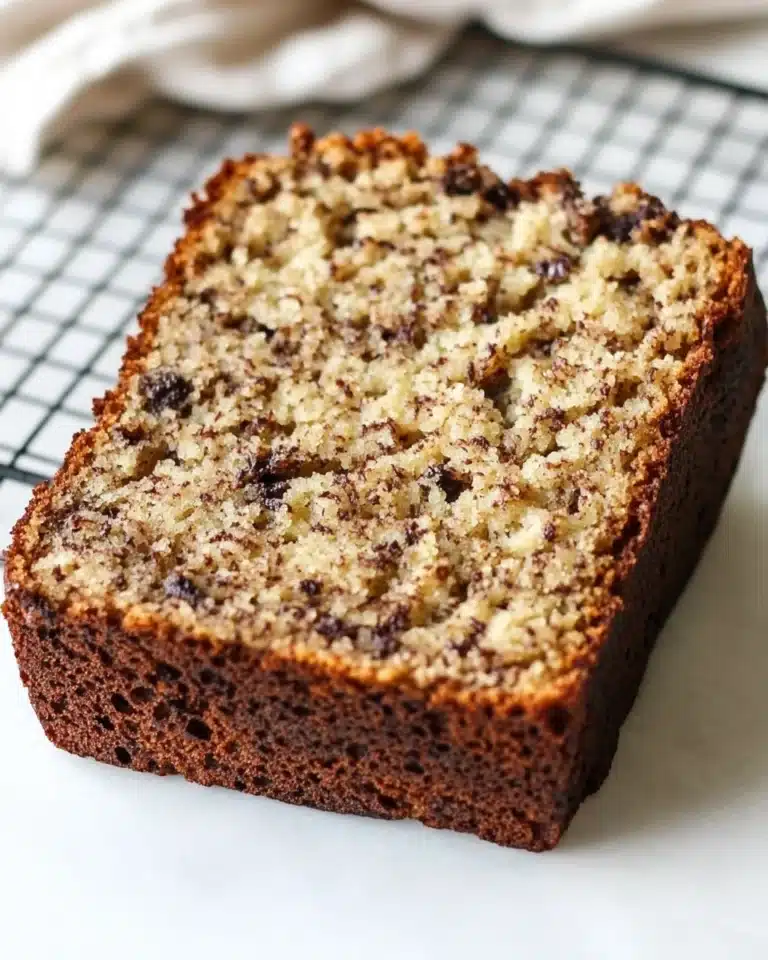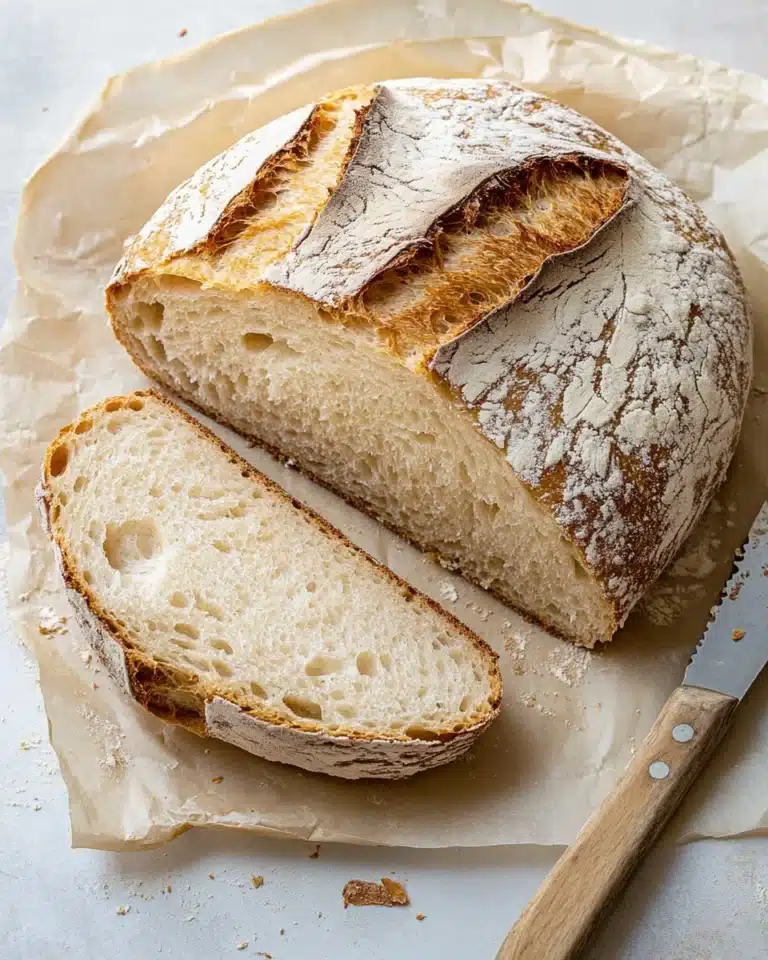If you’re ready to unlock the magic of fresh, crusty homemade bread, this Sourdough Bread Recipe is your new kitchen adventure. With just a few simple ingredients and a little patience, you’ll be rewarded with that perfectly golden crust and a tender, chewy crumb. It’s not just bread—it’s pure joy, and once you taste that first warm slice, you’ll understand why this Sourdough Bread Recipe is beloved by so many home bakers.

Ingredients You’ll Need
The beauty of a great Sourdough Bread Recipe is how it comes together with just a handful of pantry staples. Every single ingredient plays an important role in flavor, texture, and that signature rise—there’s no skipping or substituting when you want the best loaf possible.
- Bread flour: The foundation of your bread, bread flour provides the protein and structure needed for an airy, chewy loaf.
- Water: Hydrates the flour and activates the starter; be sure to use room temperature water for best results.
- Sea salt: Enhances flavor and helps strengthen the dough, so don’t be tempted to reduce this key ingredient.
- Sourdough starter: The living heart of this Sourdough Bread Recipe; make sure it’s bubbly and active for the most reliable results.
- Brown rice flour (for dusting): Keeps your dough from sticking to the proofing basket and adds a rustic touch to your bread’s crust.
How to Make Sourdough Bread Recipe
Step 1: Feed Your Starter
Before you begin, feed your sourdough starter 3 to 4 hours ahead of time. You want it lively, bubbly, and ready to work its magic in your Sourdough Bread Recipe. This is a key moment, so don’t rush it—the loaf that’s waiting for you at the end will thank you!
Step 2: Mix Water and Starter
In a large mixing bowl, combine the water and sourdough starter. Mix it with a dough whisk or your hands until everything is thoroughly combined. This ensures your starter is evenly distributed for a consistent rise and delicious sourdough tang in every bite.
Step 3: Add Bread Flour
Pour the bread flour into your starter mixture and mix well until a rough, shaggy dough forms. Don’t worry—it won’t look perfectly smooth yet. At this stage, the flour is absorbing moisture and preparing for later gluten development.
Step 4: Incorporate Salt and Rest
Add the salt, then use the pincer method: pinch and squeeze the dough between your thumb and forefinger, fold it, and pinch again. This not only disperses the salt but starts building the dough’s structure. Cover and let it rest for 20–30 minutes—patience allows the dough to become more elastic and easier to work with.
Step 5: Stretch, Fold, and Ferment
Give your dough two sets of stretches and folds, 30 minutes apart. Simply pull one side of the dough up and over the center, rotating the bowl as you go. Then, cover and let it ferment at room temperature (about 75°F) for 1 1/2 to 2 hours, until it’s risen and feels airy.
Step 6: Shape and Proof
Gently shape your dough into a boule (round) or batard (oval), then dust a banneton or proofing basket with brown rice flour. Place the dough top-down into the basket, sprinkle with more rice flour on top, and cover with plastic. This slow and gentle shaping helps develop that signature open crumb in your Sourdough Bread Recipe.
Step 7: Cold Proof in the Fridge
Let your dough cold proof in the refrigerator for 12–18 hours. This long rest deepens the flavor and improves the texture. Plus, it makes scoring and handling much easier!
Step 8: Preheat the Dutch Oven
While your dough finishes proofing, preheat a 5–7 qt Dutch oven at 450°F for at least 30 minutes. This makes sure your bread gets that gorgeous oven spring and crust as soon as it hits the hot pot.
Step 9: Score and Bake
Flip your dough onto parchment paper, score the top with a sharp knife, and quickly transfer it into the hot Dutch oven. Bake covered for 20 minutes, then remove the lid and bake an additional 15–20 minutes to brown and crisp the crust.
Step 10: Rest and Slice
Once it’s out of the oven, let your sourdough loaf rest for 30–60 minutes—yes, even though it’s tempting! This step allows the inside to finish setting, so each slice is perfect and never gummy.
How to Serve Sourdough Bread Recipe

Garnishes
A simple slather of butter and a sprinkle of flaky sea salt is unbeatable, but don’t be afraid to get creative with your Sourdough Bread Recipe. Try fresh herbs, a drizzle of olive oil, or even a touch of honey for a sweet-salty treat. A light dusting of coarse flour on top gives it that artisan look you see in bakeries.
Side Dishes
This hearty loaf pairs beautifully with just about anything. Serve alongside creamy soups, vibrant salads, or a classic cheese and charcuterie board—you’ll love how the tangy crumb complements both savory and fresh flavors. Freshly toasted slices also elevate eggs at breakfast or sit perfectly under a piece of grilled salmon for dinner.
Creative Ways to Present
Impress your guests by turning your Sourdough Bread Recipe into croutons or crostini, or hollow out a small round for a fun bread bowl appetizer. For gatherings, slice the loaf and arrange it in a rustic basket lined with a linen towel—the golden crust and pillowy interior make a statement all on their own.
Make Ahead and Storage
Storing Leftovers
Keep your leftover sourdough fresh by wrapping it in a linen bag, storing in a paper sack, or placing it in a bread box. This helps preserve its perfect crust while keeping the inside nice and soft for 2 to 3 days. Avoid sealed plastic bags that trap moisture and ruin the crust’s crunch.
Freezing
Yes, you can freeze your Sourdough Bread Recipe! Cool the loaf completely, slice if desired, then wrap tightly in plastic and foil. Store in the freezer for up to 2 months. When you’re ready, simply thaw at room temperature—your bread will taste as fresh as the day you baked it.
Reheating
To revive leftover or thawed sourdough, pop it in a 350°F oven for 5–10 minutes. This brings back its original crispiness and makes the crumb warm and inviting again. If you’re reheating slices, a toaster works wonders too!
FAQs
How do I know if my sourdough starter is active enough?
Your starter should be bubbly, slightly risen, and pass the “float test”—a spoonful should float in water. If it isn’t active, feed it and try baking again in a few hours for best results in your Sourdough Bread Recipe.
Can I use all-purpose flour instead of bread flour?
Bread flour is preferred for its higher protein content, which gives the loaf its signature structure and chew. However, you can sub in all-purpose flour in a pinch, though your bread might turn out softer and less lofty.
Why do you use brown rice flour for dusting?
Brown rice flour is less likely to absorb moisture from the dough, which helps prevent sticking in the proofing basket. It also adds a subtle nutty note and a beautiful, rustic finish to your Sourdough Bread Recipe.
Do I really need a Dutch oven?
A Dutch oven creates a steamy environment for your bread to rise beautifully and develop that coveted crust. If you don’t have one, try using a heavy oven-safe pot with a lid or bake your loaf with a pan of hot water on the oven floor for steam.
How can I make my sourdough crust extra crispy?
For ultimate crispiness, make sure your dough bakes in a well-preheated Dutch oven, remove the lid for the last 15–20 minutes of baking, and let the loaf cool completely before slicing. This Sourdough Bread Recipe rewards your patience with a beautiful crackly crust!
Final Thoughts
If you’ve been dreaming about mastering your own bakery-worthy loaf, this Sourdough Bread Recipe is the perfect place to start. Dive in, enjoy the process, and savor every fragrant, fresh-baked slice—you’ll be so glad you did!
PrintSourdough Bread Recipe
This beginner-friendly sourdough bread recipe yields a loaf with a crispy golden crust and a tender, chewy crumb. Using only a handful of simple ingredients and a slow fermentation process, this classic bread is deeply flavorful and perfect for sharing at the table. The recipe includes detailed, step-by-step instructions and helpful tips, making it easy to succeed on your sourdough journey, even if it’s your first try.
- Prep Time: 30 minutes
- Cook Time: 40 minutes
- Total Time: 15 hours 10 minutes
- Yield: 1 loaf (about 12 servings)
- Category: Bread
- Method: Baking
- Cuisine: American, European
- Diet: Vegetarian
Ingredients
Main Dough
- 400 grams bread flour (about 3 cups)
- 300 grams water (about 1 1/4 cups)
- 11 grams sea salt (2 teaspoons)
- 100 grams active sourdough starter (about 1/2 cup)
For Dusting
- Brown rice flour, as needed for dusting the banneton and loaf
Instructions
- Prepare Sourdough Starter: Feed your starter 3–4 hours before you plan to make the bread, or until it’s bubbly and active.
- Mix Wet Ingredients: In a large bowl, use a dough whisk or your hands to mix together the water and the starter until fully combined.
- Form Initial Dough: Add the bread flour to the starter mixture and mix well until the dough becomes shaggy and all the flour is hydrated. Let it rest for 20–30 minutes covered to allow the flour to absorb the water (autolyse).
- Incorporate Salt: Sprinkle in the salt and use the pincer method (squeezing the dough between your thumb and forefinger) to combine. Fold the dough in half and pinch again, repeating as needed. Cover and let rest for another 20–30 minutes.
- Stretch and Fold: Perform two sets of stretch and folds, spaced 30 minutes apart, to develop gluten. To do this, reach under the dough, gently stretch it upward, and fold it over itself. Cover and rest at room temperature (about 75°F) for 1 1/2 to 2 hours, until slightly puffed.
- Shape the Dough: Turn the dough onto a lightly floured surface and shape it into a boule (round) or batard (oval). Dust a 7-inch banneton or proofing basket with brown rice flour, place the dough top-side down in it, dust generously with more brown rice flour, and cover loosely with plastic.
- Cold Proof: Refrigerate the dough in the banneton for 12–18 hours to cold proof and allow flavors to develop.
- Preheat Oven: Place a Dutch oven with its lid inside the oven and preheat to 450°F for at least 30 minutes before baking, ensuring the pot is thoroughly heated.
- Score and Bake: Remove the dough from the fridge, turn it out onto parchment paper, and score the top with a sharp blade. Quickly transfer the dough (on parchment) into the hot Dutch oven. Bake at 450°F for 20 minutes with the lid on, then remove the lid and continue to bake for 15–20 minutes, until deep golden and crisp.
- Cool and Serve: Remove the bread from the Dutch oven and cool on a wire rack for at least 30–60 minutes before slicing. This rest allows the crumb to finish setting, so slice only when fully cooled for best texture.
Notes
- Weighing your ingredients yields the most consistent results, but you can use volume measurements in a pinch.
- Store sourdough bread in a linen bag, paper sack, or bread box for up to 2–3 days for maximum freshness.
- Let the bread cool completely before slicing to avoid a gummy texture inside.
- The longer the cold proof, the tangier the flavor develops, but do not exceed 18 hours for best results.
Nutrition
- Serving Size: 1 slice (1/12 loaf)
- Calories: 120
- Sugar: 0g
- Sodium: 365mg
- Fat: 0g
- Saturated Fat: 0g
- Unsaturated Fat: 0g
- Trans Fat: 0g
- Carbohydrates: 26g
- Fiber: 1g
- Protein: 4g
- Cholesterol: 0mg








